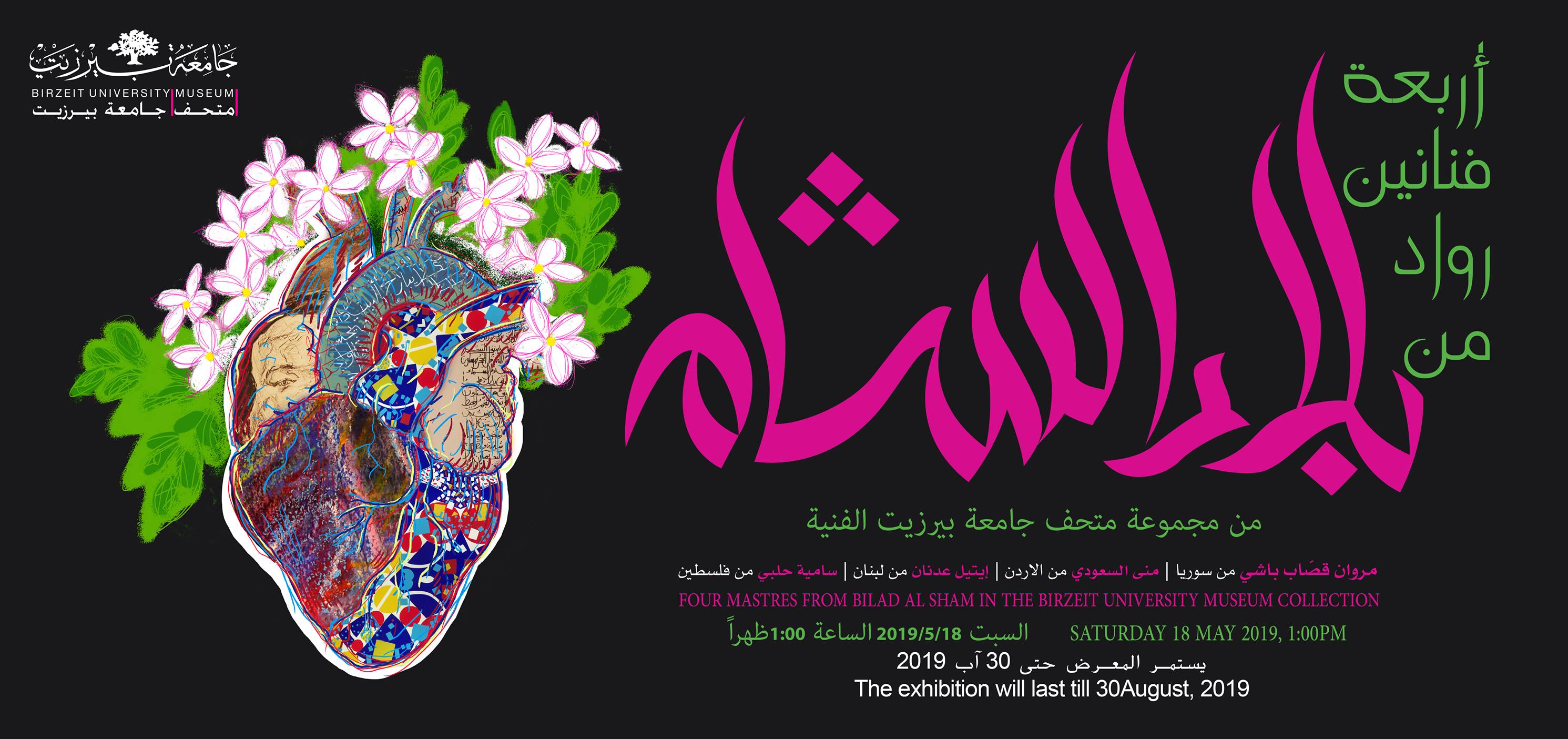
This exhibition comes as part of an overall program of showcasing Birzeit University Museum’s ethnographic and art collections. The museum’s collections have been steadily growing and expanding in size and breadth thanks to the generous donations of artists and collectors from Palestine, the Arab World and the world at large.
The theme of of this exhibition has been chosen in light of the successive changes taking place in Bilad al-Sham (Greater Syria & Palestine – the Levant). Nameley those which have continuously striven to fragment this cultural and historic whole into splinters of ethnic, sectarian, and political differences in an attempt to create new realities on the ground and revitalise outaded divisions and differences which any inquisitive mind can discern and expose. New generations have somewhat become oblivious to the deep cultural harmony that once united Bilad al-Sham over the centuries, particularly in light of the increasingsense of regionalalisation and the attempts to turn it into apermanent national identity.
By celebrating the works of four different artists from Bilad al-Sham in the University’s collections, this exhibition is a cry of defiance in the face of regionalism sectarianism, localism and tribalism. It is an attempt to retrieve and highlight our collectives similarities in Bilad al-Sham through artistic expression and talent.
Each of the three female and one male artists showcased in this exhbition reflect divergent and independent schools of thought and artistic identities. What unites them is a collective sensibility that is informed by life in exile, away from the homeland as is the case of many of the Arab world’s artists and itellectuals.
Artists’ Biographies:
Samia Halaby Born in Jerusalem in 1936 is a Palestinian abstract painter and an influential scholar of Palestinian art. Although based in the United States since 1951, Halaby is recognized as a pioneer of contemporary abstraction in the Arab World. Influenced by the abstract movements of the Russian Avant-Garde, Halaby works with the conviction that new approaches to painting can redirect ways of seeing and thinking not only from within the realm of aesthetics but also as contributions to technological and social advancement. Her work has been collected by international institutions since the 1970s. Samia Halaby has been hosted numerous times at Birzeit University since the 1990’s -as artist in residence- where she conducted art workshops for the University students. Moreover, the BZU Museum held in 2017 a special exhibition of her drawings of the Kufur Kassem massacre which she generously gifted to the University.
Marwan Kassab Bachi Born in Damascus 1934 and died in Berlin in 2016. A Syrian artist known by his artistic pen-name “Marwan”, he had studied Arabic literature in Damascus University, and later graduated from the Department of Painting at the Higher Institute of Fine Arts in Berlin in 1963. He lectured at the same institute and became a permanent teacher there in 1980. Influenced by his aesthetic memory of Syria, Kassab Bachi’s work is regarded among the most prominent in German expressionism. In his work, he addresses humanitarian issues by focusing on the enduring human face, which every so often transforms into the rocky and earthen scenes of nature or into a structural culmination of colours and hues. Kassab Bachi has held more than 80 solo exhibitions worldwide and he is considered one of the most exhibited Arab artists in the world. Birzeit University inaugurated in 1998 his gift of 75 works in an exhibition entitled “To the Children of Palestine” which also toured in Jerusalem, Gaza and several Palestinian towns.
Etel Adnan Born in Beirut 1925, is a Lebanese-Syrian artist who at the age of 24 traveled to Paris where she received a degree in philosophy from the University of Paris. She then traveled to the United States where she continued her graduate studies at the University of California, Berkeleyand Harvard University. From 1952 to 1978, she taught philosophy of art at the Dominican University of California in San Rafael. Upon her return from the US, worked as a journalist and cultural editor for Al-Safa a French language newspaper in Beirut. Her work was exhibited amongst other places at Documenta 13 in Kassel, Germany, the Whitney Museum of American Art, and the Arab Museum of Modern Art in Doha in an exhibition entitled “Etel Adnan in all her Dimension” which included 11 different artistic dimensions of her early work including also her literary works and her woven pieces. Adnan who is the recipient of many international award says that she was lucky to visit Palestine in1966, before the whole of Palestine was occupied, and where she stayed at Musa al-'Alami’s mansion/farm in Jericho. That same year, Etel made an application for work at Birzeit collage as lecturer of cultural studies
Mona Saudi Born in Amman in 1945, is a Jordanian-Palestinian sculptor, publisher and activist. Saudi studied sculpture at the École Nationale Supérieure des Beaux-Arts in Paris, and has been living in Beirut since 1966. Saudi is one of the most renowned sculptors in the Arab world; she is widely recognized for her stone sculptures which explore the relationship between natural materials and modern forms. Mona Saudi is also known to have transformed the poetry of Mahmoud Darwish, Adonis, Amru al-Qais and Sain-John Perse into drawings/prints and sculptural interpretations. Her work has been exhibited and acquired by museums around the globe, many of which are on permanent display, namely a monumental sculpture at the entrance of the Institute of Arab Art in Paris.
